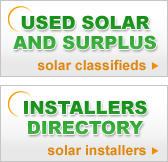
|
Utah residential solar energy incentivesRenewable energy systems personal tax credit The investment tax credit for residential systems is 25 percent of the equipment and installation cost up to a maximum of $2,000 per residential unit. Eligible residential systems include active and passive solar thermal systems; solar electric systems; wind turbines; hydro energy; geothermal heat pumps; direct-use geothermal; and biomass. Credit may be carried over up to four years if unused, but the credit is nonrefundable. Questar Gas – residential solar assisted gas water heating rebate program Residential customers of Questar gas who purchase and install solar water heating systems in their home are eligible for this rebate. Customers who install solar panels to assist their gas water heaters will receive a rebate of $750 per system. Customers must include a receipt or invoice that shows the date
of purchase, description of equipment and price with their applications
to qualify. Rocky Mountain Power – solar incentive program Customers of Rocky Mountain power who install photovoltaics are eligible for this incentive program. Through December 31, 2011, residential customers will receive rebates of $2.00 per watt (AC) up to $6,000. The program is limited to a total of 57 kW for residential per program year. Eligible systems may not be greater than 25 kW and must be net-metered. Pre-installation and post-installation inspections as well as a utility safety inspection will be conducted to ensure the system is installed properly. If the total annual production of the PV array is reduced by more than 25% due to shading applications will be rejected. So be sure to place the photovoltaics accurately. Net Metering Net Metering allows customers to connect renewable energy systems to the grid for their own use and to supply excess electricity to the electric grid. Customer-generated electricity may be from solar, wind, small hydropower, or fuel cell systems of up to 25 kW in size. The utility will "net" the customer's electricity use and production over the monthly billing period, in essence, paying the customer retail price for the electricity they produce. If net metering results in excess customer-generated electricity over the billing period, the utility will credit the customer for the electricity at the avoided cost rate. The customer may use the credit to offset purchases of electricity during future billing periods in the same energy year (April 1 – March 31). Any unused credits expire at the end of the energy year. Residential Renewable Energy Tax Credit This federal personal tax credit allows the taxpayer to claim a credit of 30% of expenditures including labor costs and installation of qualified residential solar-electric systems, solar water heating systems or fuel cells. Small wind-energy systems and geothermal heat pumps can also be accredited for. Solar-electric systems and solar water heaters have a maximum incentive of $2,000 if placed in service before 2009. There is no maximum incentive for systems placed after 2008. The excess amount of the federal tax credit may be carried forward to the next taxable year if it exceeds tax liability. This can be carried forward until 2016, but after that, it is unknown if the unused credit will be able to be forwarded. Residential Energy Conservation Subsidy Exclusion This is a personal exemption of 100% of energy conservation subsidies provided by public utilities. The value of a purchase or installation of any energy conservation measure by a customer such as solar water heat, solar space heat or photovoltaics will not be included in the customer’s gross income. Customers of an electric utility company, who participate in
the utility’s energy conservation program, may receive a rate
reduction of electricity furnished or a nonrefundable credit against
the purchase price of the electricity on each monthly electric bill. Energy-Efficient Mortgages This is a federal loan program where homeowners can use EEM (energy-efficient
mortgages) to finance renewable energy technologies in a home.  |







